
As adult children move away from dependance on their primary attachment figure and form other significant intimate relationships, we learn more about ourselves, our relational needs, and how to communicate in ways that help us feel understood, seen, and loved in relationships.
Understanding attachment styles is a common interest for adult clients seeking therapy for themselves or their partner(s).
The four primary attachment styles are secure or insecure (anxious-pre-occupied, dismissive-avoidant, and fearful-avoidant).
I’ll briefly outline the major characteristics of each and provide some tips that can be helpful as you move towards a more secure attachment.
Secure
*Positive/ stable view of self and others
*Interdependence
*Able to trust self and others
*Comfortable with intimacy
*Able to self-regulate and seek appropriate support
*Healthy boundaries
Tips: Surround yourself with others who help reinforce a positive view, engage in routine maintenance therapy to be emotionally strong as an individual and within relationship(s) as you process and work through thoughts/ feelings within various relational dynamics.
Insecure (Anxious-Pre-occupied, Dismissive-Avoidant, Fearful-Avoidant)
Anxious-Preoccupied:
*Negative/ insecure view of self but positive/stable view of others
*Dependence or clinginess (tends to be a pursuer in relationships)
*Low self-esteem
* Fearful of losing relationships/ fear of rejection
*Seeks approval & validation from others
*Porous boundaries
Tips: Improve self-esteem. Build self-confidence. Increase tolerance of being alone. Work on receiving internal validation. Do some work on setting and maintaining boundaries. Consider individual therapy first to help find your voice and feel stronger as a person.
Dismissive-Avoidant
*Positive/unstable view of self and negative/ insecure view of others
*Independent and self-reliant
*Comfortable without close relationships
*Afraid of intimacy (tends to be a withdrawer)
*Independence is prioritized; may self-isolate
*Suppression of emotions
*Rigid boundaries
Tips: Explore factors influencing your view of self and others, work on becoming more comfortable asking for help, work on fears of intimacy and becoming more vulnerable within relationships, increase comfortable naming and expressing emotions. Consider adding couples therapy to individual sessions.
Fearful-Avoidant:
*Negative/ insecure view of self and others
*Seeks but avoidant of closeness/ intimacy
*Difficulty trusting and opening up emotionally
*Afraid of being hurt by others
*Discomfort with expression love and emotions
*Inconsistency with patterns, including with setting and maintaining boundaries (e.g. supportive then unavailable)
*Pursuing and withdrawing (to avoid being hurt)
Tips: Build a positive view of self and others, explore underlying fears that impact intimacy & trust, address underlying traumas, try building a foundation of trust and opening up in therapy to learn a healthy model to practice outside of session.
Learn more about your attachment style by taking Dr. Diane Poole Heller’s attachment-styles-quiz and discussing this with your therapist.
Written By: Charlotte Johnson, MA, LPCC
We’re Here to help
Our wellness experts will be happy to take care of you. You can CLICK HERE to schedule an appointment now or call (612)223-8898.
Meet Clinicians
We’re united by our commitment to providing effective, relevant, and innovative mental health support at all stages of your journey. Click Here to find a therapist or find out more about who we are, where we come from, and how we live out CARE’s mission every day.
The professionals at CARE are actively collecting and creating resources to help with what you need and address frequently asked questions. We’re Here for You.



